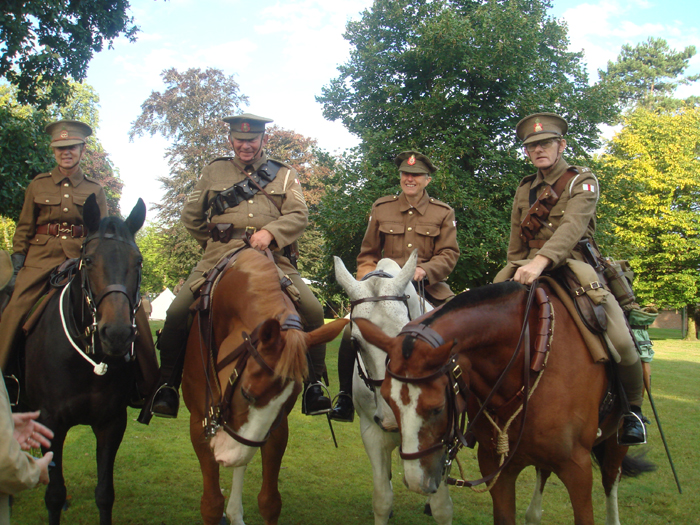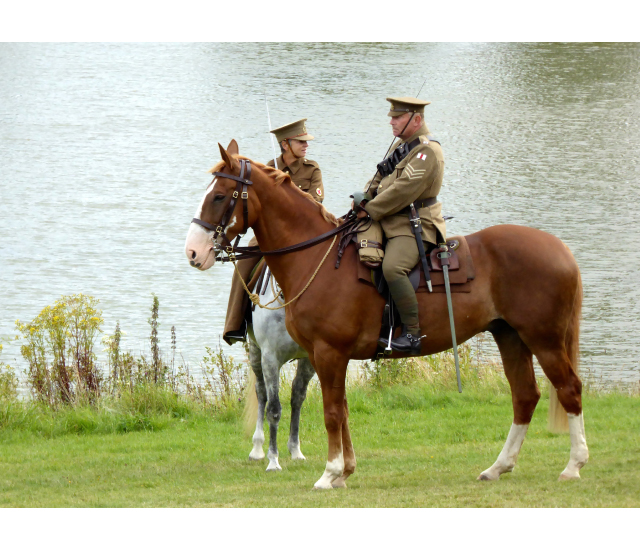In the Spring of 1915 the Sussex Yeomanry were stationed at Canterbury and were part of the South-Eastern Mounted Brigade. Training was carried out at a Squadron, Regimental and Brigade level. The Regimental horse show was held in May and cricket was played regularly at the Canterbury Ground.
The effect of the war however started to make itself felt. The quality of remounts began to deteriorate and the regiment’s rifles were called in. Those weapons were replaced with Japanese carbines which were much smaller than the short Lee-Enfield 303 and would not stay in standard rifle buckets. This meant that they had to be carried on a man’s back which was most uncomfortable.

The Sussex Yeomanry Group – Image from LRG Photography
The end of August 1915 saw the regiment asked to volunteer for dismounted service in the Mediterranean, which it did. On September 21st 1915 the regiment marched on foot to Canterbury station. In the short time between the end of August and mid-September there was a ‘crash’ course on how to be an infantryman. This involved learning how to fit webbing, taking part in foot attacks, bomb throwing, trench digging, bayonet practice and P.T. One good thing was that members of the regiment were re-issued with the short Lee-Enfield rifle and were given sun helmets. Sadly though for a cavalry man, swords and bandoliers were withdrawn.
From Canterbury the regiment travelled to Liverpool where they boarded the Royal Mail ship by the name of Olympic. In all there were about three brigades of yeomanry on board this ship. The Olympic was a sister ship to the Titanic and the Britannic. For those who are interested, she had an interesting record that can be viewed at http://www.eastsussexww1.org.uk/whitestar-liners/.
The ship steamed out of Liverpool into the Mersey amid huge speculation as to her final destination. By the time the Olympic reached the Bay of Biscay the sea conditions were very rough and down in the cramped troop accommodation most of the men were very sick. Sea conditions improved by the time the ship reached the straits of Gibralter. The ship had no escort and moved at night as there was a danger of submarine attack.
On entering the Mediterranean, weather conditions improved. The Olympic had plenty of deck room and the choirs of the Welsh regiments gave concerts under the stars. There was also boat drill (it was questionable whether there were enough lifeboats for all on board), P.T. and lectures.
At one point the ship picked up survivors from a small French sailing vessel that had been sunk by a German submarine. On the afternoon that happened, the alarms sounded and all on board went to their lifeboat stations. The ship took on a heavy list as it turned and a loud bang was heard aft. What had happened was that a submarine had surfaced in front of the ship! It was an Australian submarine and the men on board were as shocked and surprised at seeing the ship as were the men on the ship at seeing it! The Olympic turned and fired its stern gun and the submarine dived and was not seen again.
On 4th October, the Olympic steamed into Mudros Harbour which was full of military shipping.
The Sussex Yeomanry disembarked onto the SS Sarnia, which had been a cross-channel ferry between Southampton and Le Havre. Curiously one of the crew of the ferry had been a member of the Sussex Yeomanry.
From Murdos Harbour the SS Sarnia transported the yeomanry to Lancashire Landing. On disembarkation the troops were issued with rations and were moved up to a point just behind the Front Line.
Until the end of August 1915 the Sussex Yeomanry Regiment had trained as cavalry. They had been given a few weeks of infantry training until mid-September from which time – until 8th October 1915 – they had been on board a ship. Then, suddenly, they were within rifle-shot of the Turkish lines…..a great deal had to be learned – very quickly!
This story was submitted by John Dudeney of the Sussex Yeomanry Historical Group








